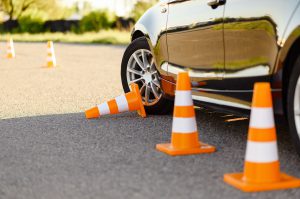Moving Off & Stopping
You should be able to move away under control and with due regard for other road users and also be able to stop the car under control in a Safe, Legal and Convenient place.
The procedure for moving off is in three parts, Preparation, Observation and then Move
Preparation
Assume that the engine is running and that you want to move off the first thing that you have to do is prepare the car, this consists of putting the clutch pedal down to the floor and selecting first gear, this is the gear that you will use for moving off on a flat road or uphill. The next thing that you must do is to set the gas; this means pressing the gas pedal slightly and holding it still, this generates sufficient power to move. Listen to the engine noise. Don’t let the engine roar! Bring the clutch up until the sound of the engine drops slightly and then keep both feet still (this is called the ‘biting point’).
Observation
You must check the road ahead and behind through all mirrors. Be prepared to wait if the road is not clear. You must also check your blindspots just as you are about to move off. As well as deciding whether it is safe to move off you must ask yourself whether it is necessary to give a signal before moving. If there is not the slightest chance of any-one being affected by you moving off, including oncoming traffic and pedestrians, there is no point in signaling. But if there is any sign of life anywhere near you, why risk it?
Move
To enable the vehicle to move off smoothly the handbrake must be taken off, and then gently increase the gas and lift the clutch up slightly, the car will begin to move off as this is done. If the car doesn’t move let the clutch up a little more. Move away only if it is safe. When the car is moving you will have to gently steer away from the kerb to the driving position about 1 metre from the kerb. To increase your speed, press the gas pedal gently and gently raise the clutch and take your foot away from the clutch pedal. You will need to change into 2nd gear soon after moving away.
Note: You should normally use 1st gear for moving off except when moving off down a steep hill, then it may be best to use 2nd gear
Stopping
When you have to pick a place to stop you must make sure that it is a safe place, you wouldn’t for example park near a junction or blocking an entrance, on a bend or before a hump-back bridge. You must also make sure that it is lawful to park and that there are no restrictions on stopping. There are many places where parking would cause an obstruction to other vehicles or road users.
Once you have selected a safe place to stop then you must use the Mirrors, Signal, Manoeuvre routine. You should never be taken by surprise when you check your mirrors because through regular checks as you drive along you will have a good idea about what is behind you. Just as important when stopping is to use the exterior mirrors with particular emphasis on the nearside mirror as there might be a cyclist in the ‘blindspot‘ area.
Having checked the mirrors and deciding that it is safe to stop you must then decide if you need to give a signal. A signal should be given if it will help or warn other road users, remember that signal will also help oncoming vehicles and any pedestrians as well as vehicles approaching from behind. A signal should always be given in good time but you must avoid giving any signal which may be misleading, for example if there is a road on the left prior to the place where you intend to stop the signal would have to be left until you have passed it.
The Manoeuvre part of the sequence involves slowing down at first by coming off the gas pedal and beginning to steer into position for stopping then use the footbrake progressively to bring the car to a stop in the proper place and close to the kerb. Just before the car stops the clutch pedal must be pushed right down to the floor to prevent the car engine stalling. When the car has stopped keep both feet still until you have applied the handbrake and moved the gear level into the neutral position.

The Driving Test
The examiner on the driving test will expect you to:-
- Move off safely and under control on a level road, from behind a parked vehicle and on a gradient
- Use the MSM routine
- Check your blindspot for traffic and pedestrians
- Make balanced use of the accelerator, clutch, brakes and steering
- Use the appropriate gear
